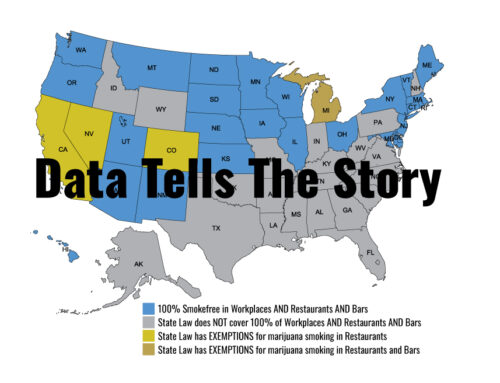5,001 and counting!
As we prepare to release our Spring Quarterly Smokefree Lists and Maps next week, we discovered something worth noting and sharing—there are now 5,001 cities, counties, and states in our U.S. Tobacco Control Laws Database© that have a clean air law. While not all of these are our gold standard—100% smokefree in all workplaces—it is a significant accomplishment.
When we started our work advocating for nonsmokers’ right to breathe smokefree air, the tobacco industry claimed that everyone smoked and that there would be mass chaos if we eliminated opportunities for people to smoke. It vehemently opposed our original advocacy for No Smoking Sections, and then suggested that sections were just fine when we began advocating for 100% smokefree environments.
We started tracking local tobacco control laws in the 1980’s, in part to document our progress and to share examples from one city to the next. At the beginning of 1980 there were less than 200 clean air laws. Today, the Laws Database is a comprehensive policy surveillance tool which contains more than 11,000 clean air laws, along with close to 5,000 laws covering sales/distribution, youth access, advertising, excise tax, and conditional use permits.
Data from the Laws Database have contributed to a large body of science on the health and financial impact of smokefree and other tobacco control laws; and the lists and maps generated by the data have been cited by journalists, advocates, and other public health professionals to document trends and gaps, and to identify areas for future policy development.
Smokefree laws are good for health and good for business.
Smokefree laws protect nonsmokers from a known human carcinogen, help smokers who want to quit by reducing the opportunities to smoke and removing cues to light up, and prevent another generation of kids from becoming smokers by role modeling tobacco-free living. Smokefree environments reduce lung cancer, prevent heart attacks, and improve general health overall.
It is quite common for those who were initially opposed to smokefree laws to reverse their opinion and voice their support for and benefits of smokefree environments – including finding that smokefree laws provide a competitive advantage over cities without laws.
“The proponents of smoking bans were very smart in that they got individual communities to enact smoking bans and then (they) became advocates for a statewide ban.”They recognized that their restaurants and bars were at a competitive disadvantage to other communities that didn’t have a smoking ban.” Todd Maisch, President and CEO, Illinois Chamber of Commerce.
Illinois preempted localities from adopting smokefree laws until 2006. The following year, over 30 municipalities enacted local smokefree laws. The state then adopted a law that went into effect in 2008 making all workplaces, including casinos, 100% smokefree. One of our mantras is “Local Leads the Way,” and Illinois is a perfect example.
Today, 58% of the population is protected by a 100% smokefree workplace, restaurant, and bar law at the local or state level. While we have made much progress, we must close the gap in smokefree protections for the remaining 42% of the population left exposed to secondhand smoke. Working at the local level will have the same impact it did in the early days of the nonsmokers’ rights movement – it will establish community demand, create a competitive advantage, improve public health, and build momentum for a statewide smokefree law.






